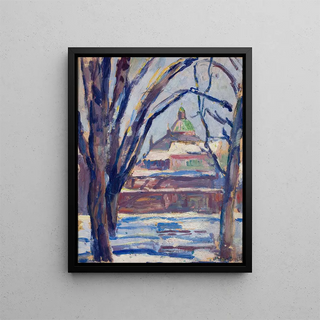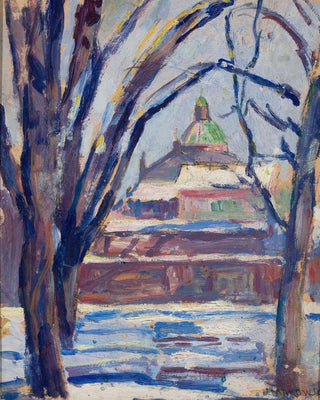Art print | Winter landscape from the church - Tadeusz Makowski


View from behind

Frame (optional)
In the enchanting universe of art, some works manage to capture the essence of a season, a moment, or an emotion. "Winter Landscape from the Church - Tadeusz Makowski" falls into this category, offering a poetic and timeless vision of winter. This painting, imbued with serenity, transports us to the heart of a landscape where snow envelops architectural and natural forms in a gentle silence. The piece invites us to contemplate the fleeting beauty of nature, while evoking an atmosphere of calm and reflection. Through this art print, the viewer is invited to an immersive experience, where the gaze wanders through shades of white and blue, and where every detail seems to tell a story.
Style and uniqueness of the work
Tadeusz Makowski's style is distinguished by its delicate approach and subtle color choices. In "Winter Landscape from the Church," the artist skillfully plays with light and shadow, creating a striking contrast that brings the scene to life. The rooftops of the buildings, covered in snow, emerge as delicate silhouettes, while the trees stand proudly, their branches laden with snowflakes. This art print is not limited to depicting a winter landscape; it also evokes a sense of nostalgia and contemplation. The composition, well balanced, guides the eye across the artwork, inviting an exploration of the various elements that compose it. Every brushstroke seems to be a caress on the canvas, demonstrating the artist's technical mastery and keen sense of aesthetics.
The artist and his influence
Tadeusz Makowski, an emblematic figure of Polish art in the early 20th century, knew how to leave his mark on his era with his unique style. Influenced by the artistic movements of his time, notably Fauvism and Impressionism, he developed a personal approach that combines sensitivity and technical skill. His work is characterized by a constant search for beauty and harmony, which is reflected in every canvas he creates. By choosing to depict scenes of everyday life, often imbued with

Matte finish

View from behind

Frame (optional)
In the enchanting universe of art, some works manage to capture the essence of a season, a moment, or an emotion. "Winter Landscape from the Church - Tadeusz Makowski" falls into this category, offering a poetic and timeless vision of winter. This painting, imbued with serenity, transports us to the heart of a landscape where snow envelops architectural and natural forms in a gentle silence. The piece invites us to contemplate the fleeting beauty of nature, while evoking an atmosphere of calm and reflection. Through this art print, the viewer is invited to an immersive experience, where the gaze wanders through shades of white and blue, and where every detail seems to tell a story.
Style and uniqueness of the work
Tadeusz Makowski's style is distinguished by its delicate approach and subtle color choices. In "Winter Landscape from the Church," the artist skillfully plays with light and shadow, creating a striking contrast that brings the scene to life. The rooftops of the buildings, covered in snow, emerge as delicate silhouettes, while the trees stand proudly, their branches laden with snowflakes. This art print is not limited to depicting a winter landscape; it also evokes a sense of nostalgia and contemplation. The composition, well balanced, guides the eye across the artwork, inviting an exploration of the various elements that compose it. Every brushstroke seems to be a caress on the canvas, demonstrating the artist's technical mastery and keen sense of aesthetics.
The artist and his influence
Tadeusz Makowski, an emblematic figure of Polish art in the early 20th century, knew how to leave his mark on his era with his unique style. Influenced by the artistic movements of his time, notably Fauvism and Impressionism, he developed a personal approach that combines sensitivity and technical skill. His work is characterized by a constant search for beauty and harmony, which is reflected in every canvas he creates. By choosing to depict scenes of everyday life, often imbued with






